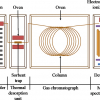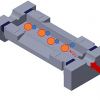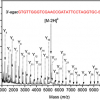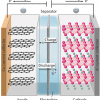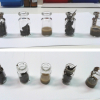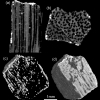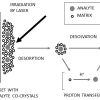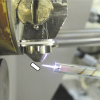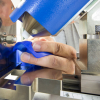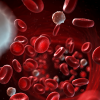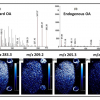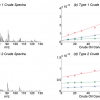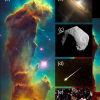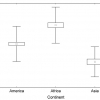Articles
Tony Davies and Roy Goodacre raise some issues around the reliance just on vast quantities of data collection in omics experiments. As they put it, should we “just keep throwing the mass spectra, nuclear magnetic resonance data sets and our ion mobility fingerprints onto a big pile for the statisticians to fight over?”.
Hafiz Abdul Azeem recently presented some interesting results from his work on atmospheric aerosols. Following their capture, he combined the optimisation of the extraction process with chromatographic separation and mass spectroscopic detection to identify various sources of pollution through their emission marker fingerprints.1 One spin-off of this work has been the use of a specific biomarker from cellulose combustion to potentially warn of low-heat smouldering in, for example, agricultural materials in bulk storage.
This article provides a valuable summary of the choice of sample clean-up methods available for the quantification of small molecules in body fluids. What are the key factors? Judy outlines the principal processing methods and provides practical advice on protocol development using quantification of serum testosterone in serum samples as the model compound.
Nick Polfer gives an excellent introduction to the recent technique of infrared ion spectroscopy. Ions held in the ion trap of a mass spectrometer can be probed with a tuneable light source, and its photodissociation studied as a function of the photon frequency. Nick believes that the technique will make an impact in small molecule analysis, such as metabolites, drugs and classes of molecules containing many isomers.
Tony Davies continues his quest to find out what you all need to work more efficiently. You will remember that in the last issue, Tony introduced his survey to discover what developments were needed in spectroscopy by readers. Some of the initial responses are explored, and Tony finds that he has opened a “can of worms”.
This article gives a most useful overview of the analysis and sequencing of nucleic acids by matrix-assisted laser desorption/ionisation mass spectrometry, which should interest all readers and may well serve as a useful tutorial article.
Lithium ion batteries power most of the electrical devices we rely on every day. As well as mobile phones, laptops and tablets, they are finding increasing use in vehicles, with electric cars not uncommon on our streets. This article is from a young scientist who has won help for her research through an instrument company’s support programme. You can find out more, read the article and even apply yourself.
The study of metabolites in our sewage systems is not new, but there are particular difficulties with identifying the metabolites from new psychoactive substances, or “legal highs”. The authors describe a wide range of sample collection methodologies and their analysis with mass spectrometry.
Dates and fates of pyrogenic carbon: using spectroscopy to understand a “missing” global carbon sink
Research into climate change takes many directions, but storing carbon or understanding its release from stores is extremely important. Pyrogenic carbon comes from the incomplete burning of biomass, and can be natural, e.g. wild fires, or man-made, e.g. the production of charcoal. The authors describe the uses of a range of spectroscopy techniques to understand the molecular structure of pyrogenic carbon and its role in the global carbon cycle.
The bio theme moves to mass spectrometry in “Solid mixed matrices and their advantages in matrix-assisted laser desorption/ionisation time-of-flight mass spectrometry” by Marek Šebela. Getting the most from various matrices for use in matrix-assisted laser desorption/ionisation (MALDI) has always been a bit of an art, and the introduction of mixed matrices may increase the number of possible combinations but may improve reproducibility and so simplify analysis in the end. The author describes mixed matrices for a range of samples including proteins, peptides, oligosaccharides, oligonucleotides, lipids, polymers and even intact microbial cells!
This article tells us about another: “Fast and versatile ambient surface analysis by plasma-assisted desorption/ionisation mass spectrometry”. They show that surface analysis can greatly benefit from approaches using surface–plasma interactions and that PADI shows significant promise to become a valuable and versatile tool for this.
In the Tony Davies Column, Tony describes “A new approach to identifying unknown trace level analytes by tandem mass spectrometry without reference spectroscopic database support: CSI:FingerID”. This allows for tandem mass spectrometry data to be used to identify unknown analytes from common molecular structure databases where reference spectroscopic data is unavailable.
Jürgen Gross has been using ambient mass spectrometry to look at the presence of polydimethylsiloxanes (PDMS) in food prepared in silicone rubber objects and on baking parchment. He shows that PDMS migrates into the food, something perhaps we should think about if in the mood for some baking!
Research is under way as to the possibility of using high-precision isotopic analysis of metals in a biomedical context. The goal is to develop methods for medical diagnosis on the basis of isotopic analysis of mineral elements in biofluids, for diseases that can otherwise only be established at a later stage or via a more invasive method (e.g., a biopsy) and/or for prognosis purposes. Whilst this work is in a very early stage, it is known that various diseases have an influence on the uptake, metabolism and/or excretion of essential mineral elements and thus, can cause a difference in their isotopic composition in biofluids.
Robert Bradshaw and Simona Francese tell us about “Matrix–assisted laser desorption ionisation tandem mass spectrometry imaging of small molecules from latent fingermarks“. Especially when looking at small molecules in fingermarks, isobaric species can be a problem and this has the potential to affect the outcome of any court case if not handled appropriately. Tandem mass spectrometry can be used as an alternative to high-resolution MS and ion mobility.
“Membrane inlet mass spectrometry for in situ environmental monitoring” by Simon Maher, Fred Jjunju, Iain Young, Boris Brkic and Stephen Taylor looks at a technique that is 50 years old but is now being applied for field analysis. As well as a brief overview of the technique, they show how it can be used to monitor oil-in-water levels before discharge from oil termini.
This article explains the challenges in pesticide residue analysis of samples associated with suspected poisoning incident investigations, including the wide range of specimens and pesticides that need to be considered.
In this article we learn of a new definition for “bath salts”, and how modern mass spectrometry instrumentation can provide rapid and quantitation of these “designer” drugs.
This article shows that pyrolysis techniques, in combination with spectroscopy, are helping our understanding of how the organic matter in our solar system came to be. Fascinatingly, they also show how secondary processing of meteorite materials seems to enhance the abilities of atmospheres to host life on planetary surfaces as well as providing the raw materials from which life could originate.
The use of isotope ratio mass spectrometry is on the rise, with more papers published and more labs with the facilities. The authors describe the main IRMS studies conducted on seeds and isotopes and outline the most important aspects of the use of seeds to study plant eco-geochemistry and plant material traceability.


